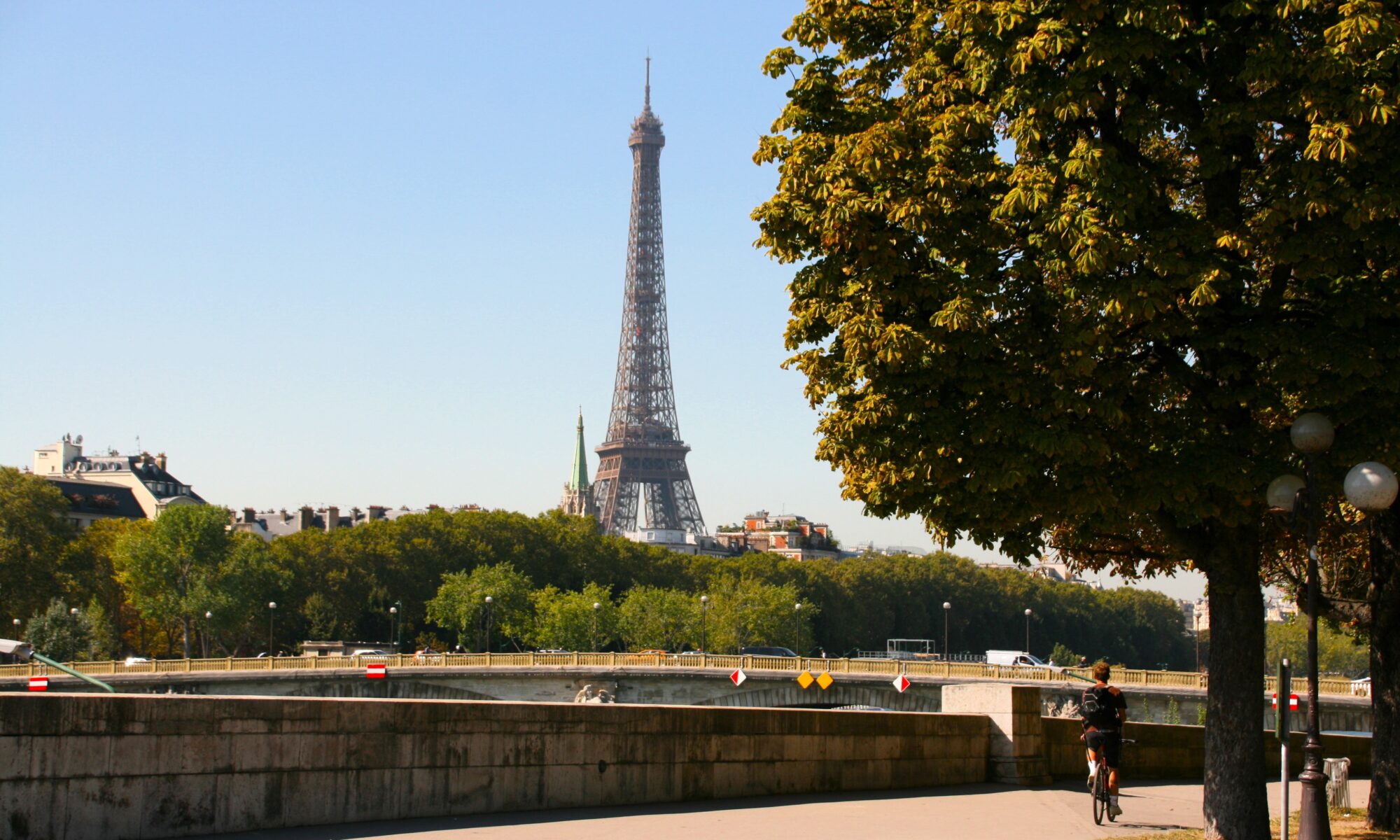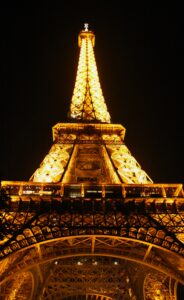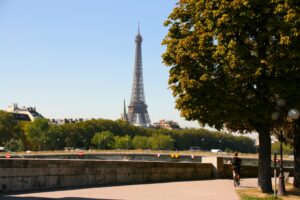In my opinion I don’t see what all the fuss is with the Eiffel Tower. The iconic monument that pierces the Parisian skyline stands on the banks of the river Siene. It is famous across the globe and even has replicas in other cities. It has lured and seduced millions of people to visit, however, I can see why it was once called “a truly tragic streetlamp”.
It’s hard to disagree with this opinion as the hourly evening light shows give a different meaning to streetlamp. It might be more aptly named a comical lighthouse as thousands of lights adorn the outside of the structure, presumably to fit in with the ‘city of light’. It mesmerizes an easily pleased crowd. Crowds they certainly are, as they swarm around the tower and nearby neighbourhoods to catch a glimpse.
The Eiffel Tower is an “industrial eyesore” that towers above the city. At the time of building it was an architectural achievement and a record breaker. Many come to study its construction, its facets of engineering. Now it is even a beacon of romance. What was once an industrial wonder is now the symbol of Paris and a monument that literally must be seen by everyone.
Designing the Eiffel Tower
When Gustave Eiffel set about designing the tower, France was preparing to host the 1889 Exposition Universelle (also known as the world fair). This coincided with an important anniversary in the French calendar – it was 100 years since the French revolution. The aim was to display to the world France’s industrial progress with an architectural achievement.
This iron monstrosity wasn’t everyone’s cup of tea. Thoughts were raised about its potential ugliness, impracticality and dangerous construction. At the time of construction Paris was a city filled with prominent artists and writers. Their concerns were that the tower would take away from the city’s great treasures, Notre Dame, The Louvre, the Arc de Triomphe. As a result, Eiffel and his team kept returning to the designs, making necessary changes, adding decorative arches and getting government approval. The government approval for the Eiffel Tower was only for 20 years.
Construction of the Eiffel Tower
Construction of the Eiffel tower officially began on 28th January 1887 on the Champ de Mars. Two years, two months and five days later the tower was completed on 31st March 1889. 300 workers assembled the tower, over 18,000 iron pieces were used in the construction, and it is held together by 2.5 million rivets.
Upon completion the tower stood 312 metres high or, in old money, 1024 feet. The Eiffel Tower had become the tallest structure in the world, surpassing the Washington monument. It would lose its title of ‘tallest structure” in 1930 to the Chrysler Building in New York.
Public reaction
Some Parisians were not fans of the industrial eyesore. They felt it was an insult to the city’s classical beauty. I have referred to some of the terms used to describe it, “a truly tragic streetlamp,” “a hole-riddled suppository,” and “a ridiculous chimney.”
Shortly after it opened, a prominent group of artists and writers signed the ‘Protest Against the Tower of Monsieur Eiffel’ which was published in Le Temps. The group included Charles Garnier (I shall visit his masterpiece the Palais Garnier), Guy de Maupassant and William Bouguereau. I quote, “We protest… against the erection of this useless and monstrous Eiffel Tower… a ridiculous smokestack crushing Notre Dame, the Louvre, the Arc de Triomphe under its barbaric bulk.” Their views were not shared by everyone. An incredible 2 million people visited during the World fair, a number that is small in comparison to the 7 million who now visit the tower each year.
The tower was meant to be a temporary structure, but it had the last laugh as it outlived its critics. Eiffel, undeterred, dismissed the backlash. He compared his tower to Egyptian pyramids. “Why would something admirable in Egypt become hideous in Paris?”
Surviving World Wars
World War 1 broke out towards the end of the 20-year permit, and demolition seemed the likely option. The Eiffel tower, though, proved to be a secret weapon – a vital communications hub for French military operations. The Eiffel tower success persuaded the government to preserve the tower permanently and after WWI it was used for public broadcasting in 1921.
During the second world war Paris was occupied by Nazi Germany. In an act of resistance, French engineers cut the tower’s elevators’ cables to ensure that the German soldiers had to climb 1,665 steps to reach the top. Hitler wasn’t a fan of the tower (unlike recently visited Ponte Vecchio where rumours are that he instructed the bridge not to be destroyed). He ordered the tower to be demolished. Fortunately (and the jury is still out on this choice of word), his command was never carried out or aborted as allied forces arrived.
Eiffel tower today
Visiting today is a scene of chaos in and around the tower. As the masses surround the tower, the pandemonium is palpable as excited humans try to work out where to go – it could be the perfect scene from ‘Oliver’. This simmering pot of excitement is the perfect place for pick pocketers and scammers to ruin your experience. There is an alarming security presence which is a sad sign of the modern times as Paris and the rest of Europe grapple with potential terrorist threats. It is such a shame for a construction that in 1991 was declared a UNESCO world Heritage Site.
Cross the river and visit any other locations to capture the Eiffel Tower and you will have to embrace remarkable scenes. Tripods, cameras, make up bags, costumes, poses, wedding dresses, you name it, combine as amateur and professional photo shoots with the tower take place. It makes the ‘Pisa pose’ seem tame.
The Eiffel tower is the most visited paid monument in the world. Getting tickets way in advance is a must. The Eiffel tower is an expensive experience. Tickets to the top are around 36 euros per adult (at the time of writing). If you want a glass of champagne at the top that will set you back another 25 euros. Personally, a glass of champagne at the top was the last thing on my mind. The top of the tower was cramped, very high up and swaying in the wind.
Eiffel Tower Summary
Not everyone will agree with my slant on the Eiffel Tower (please do let me know in the comments – either way). Were we all the same, life would be rather boring. In researching for my post, I was surprised to find out that I’m not alone in my views which brings me some comfort.
The Eiffel Tower has certainly polarised opinion since the moment it was designed. Those opinions seem a little lost in the modern world as people follow rather question. If only we could go back in time, when the meaning of life was oh so different, topics of conversation were far ranging, art was viewed, architecture admired, culture was embraced, and history was learnt.
Now life seems to be a tick box exercise of visiting, posing for a picture, country counting and following the crowd. Spontaneity, chivalrous acts and romantic gestures seem a distant past. The Eiffel Tower seems broken in a world of too much tourism. Whatever charm it had appears to be lost. They say romance is dead, and the Eiffel Tower is, to my way of thinking, a site of a massacre as hordes of photo opportunity people suck the romance out of the air.
Don’t forget to notice Gustave’s tiny apartment at the top of the tower. It was interesting to find out that Gustave was involved in the creation of the Statue of Liberty in New York. My post on New York explains why I wasn’t a fan of that city. Gustave built the metal framework of the statue.
One of Gustave’s main critics was Charles Garnier. Charles was also an architect whose most famous work was Palais Garnier. This will be my next stop. Let us see if his criticism is worthy. I will leave with words from Gustave, “I ought to be jealous of the tower. It is much more famous than I am.”









Interesting question.
Do you feel the same way about, say, the London Eye?